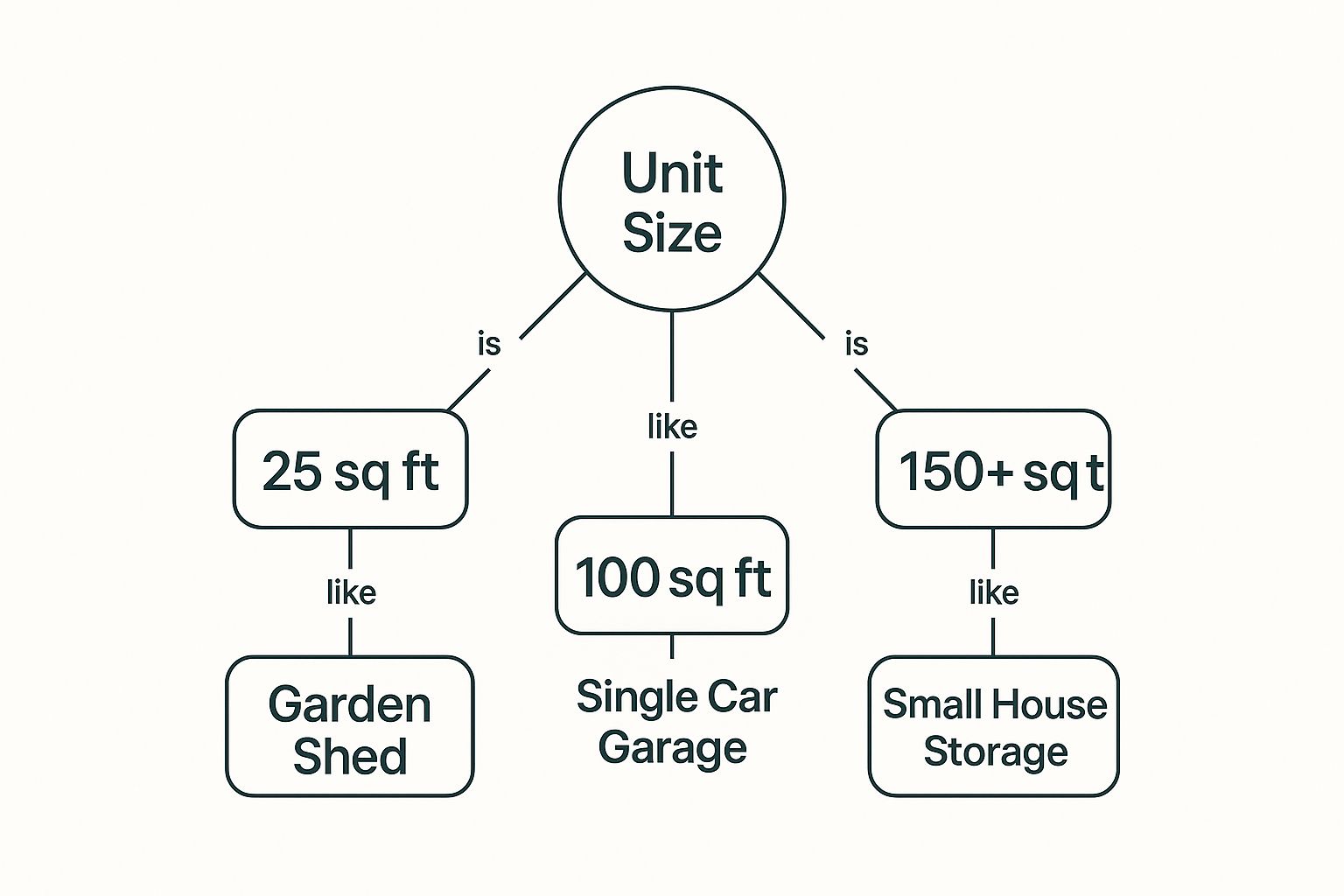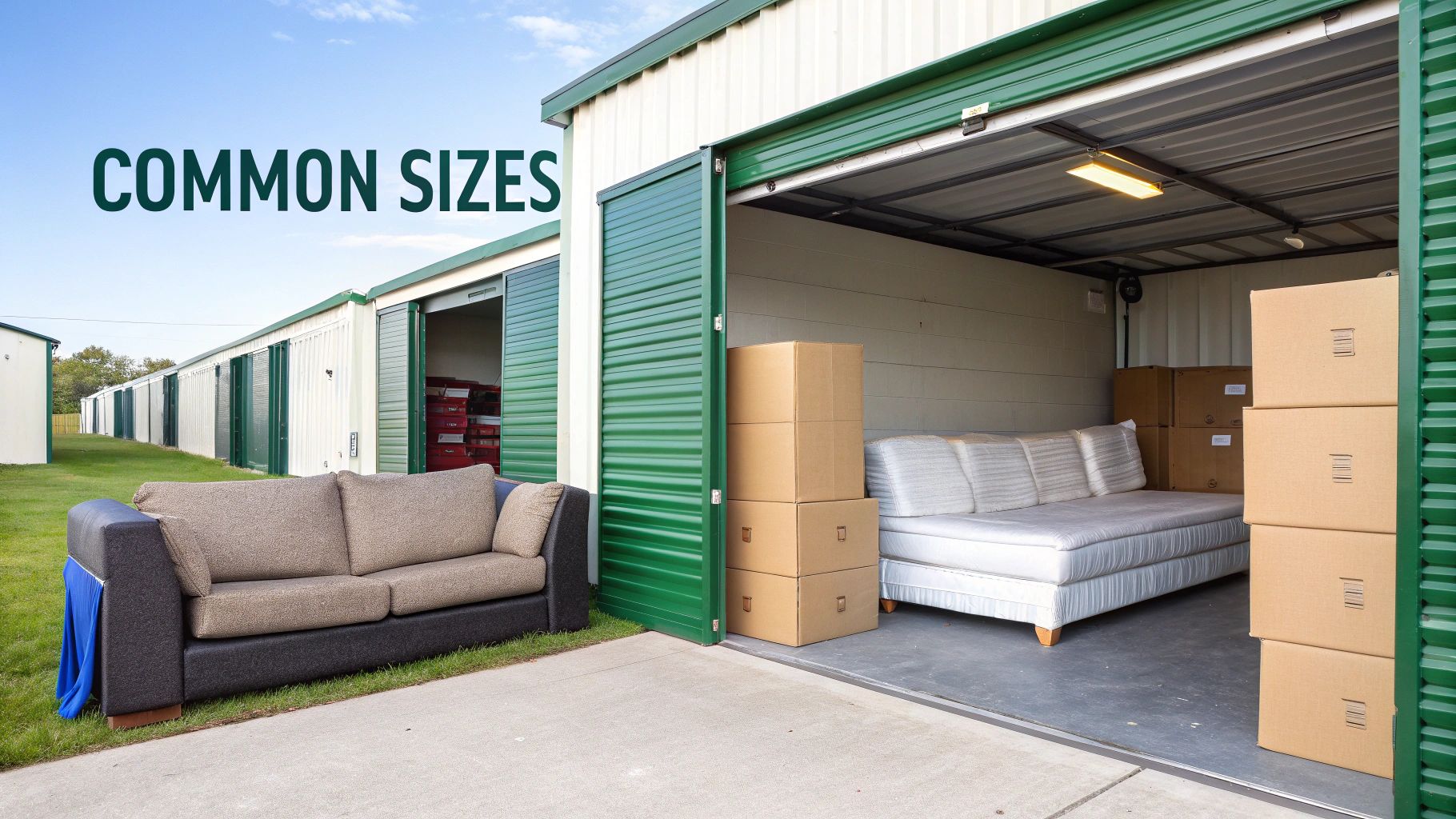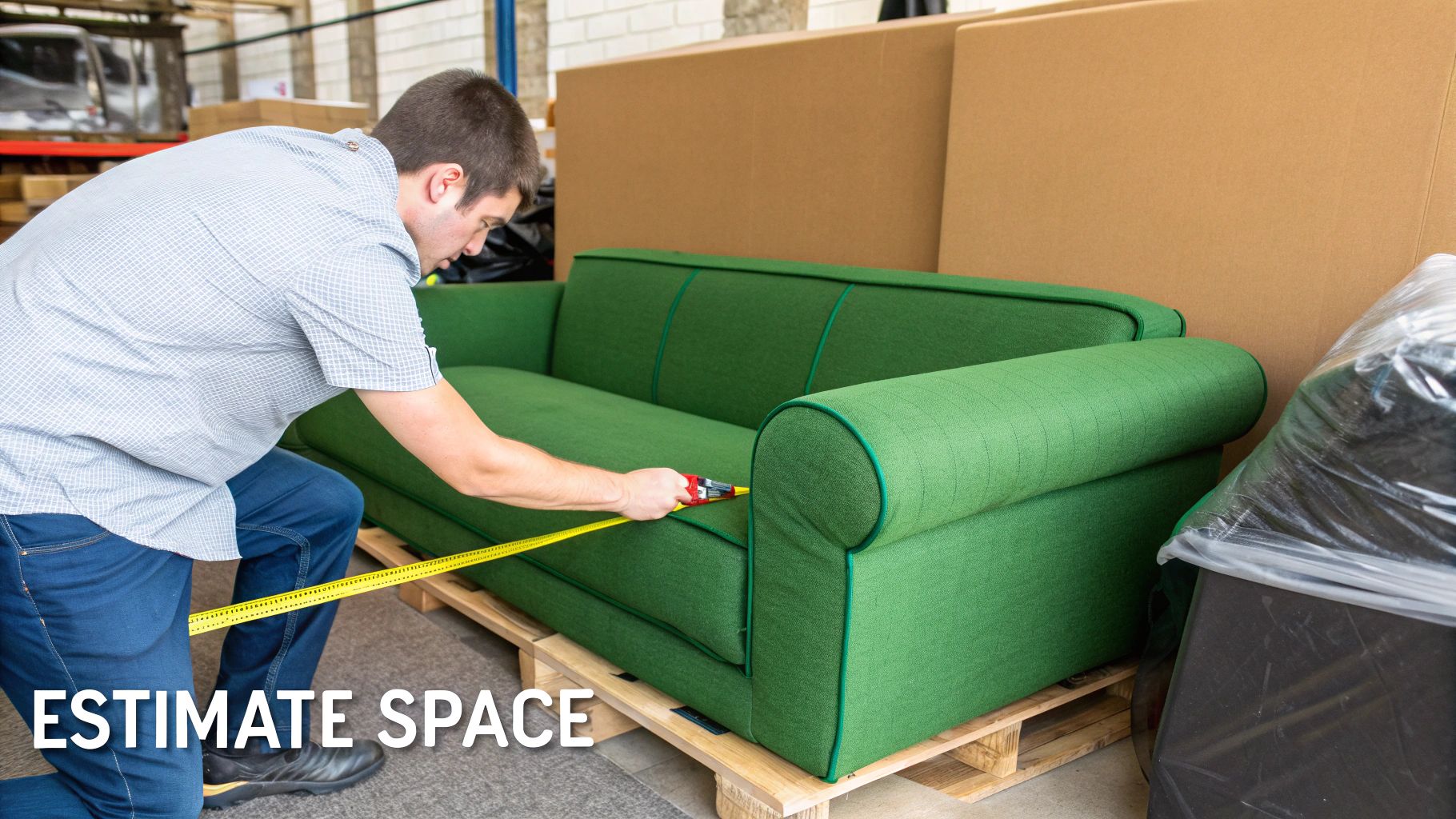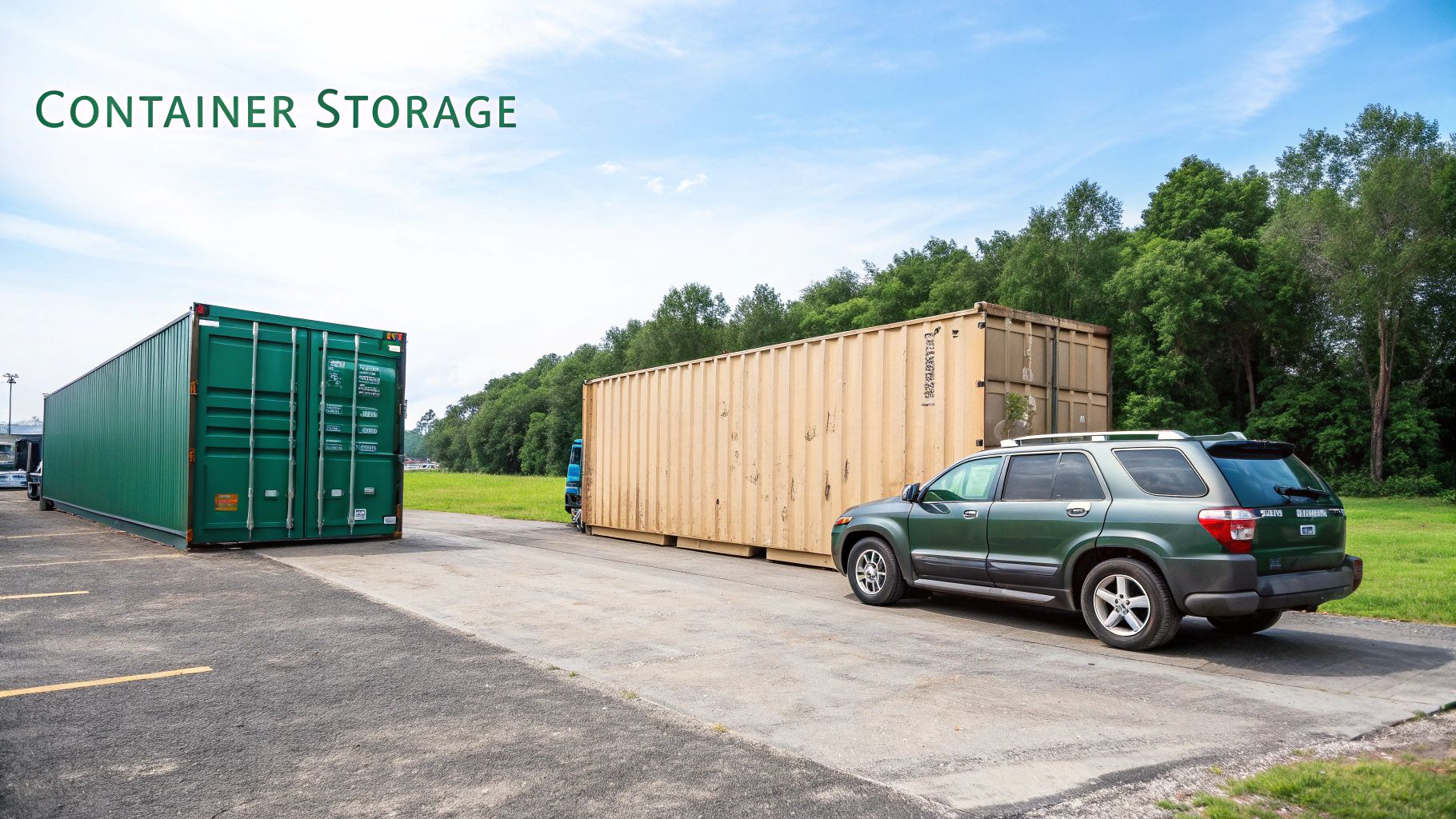Choosing Self Storage Unit Sizes in the UK
Staring at a long list of self storage unit sizes can feel a bit like trying to solve a puzzle, can't it? Let’s break it down into simple, real-world terms. Imagine a 25 sq ft unit as being roughly the size of a large garden shed – it’s perfect for stashing away boxes, seasonal decorations, or a few small pieces of furniture. On the other hand, a 100 sq ft space is much more like a single car garage, ready to swallow the entire contents of a one or two-bedroom flat.
Decoding UK Self Storage Unit Sizes
Picking the right size from the get-go is the smartest move you can make. It saves you money by ensuring you're not paying for air, and it prevents the sheer panic of realising you've run out of room halfway through loading up. My goal here is to help you feel confident enough to pick the perfect unit without any guesswork.
When you can visualise what those abstract numbers actually mean in the real world, it completely changes the game. This isn’t just about finding a space; it’s about finding the right space for what you need, whether you're in the middle of a house move, finally decluttering the spare room, or storing business stock.
The difference between a 50 sq ft and a 75 sq ft unit might not sound like much on paper, but in reality, it can be the difference between a smooth, organised move and a frustrating game of Tetris with your prized possessions.
Visualising Common Size Categories
To make things even clearer, let's group the sizes into a few general categories. This will help you quickly narrow down your options based on what you actually plan to store.
This handy infographic does a great job of linking common self storage unit sizes to things you see every day.

As you can see, connecting a measurement like '100 sq ft' to a familiar space like a 'Single Car Garage' makes it so much easier to picture what will fit.
Before we dive into the nitty-gritty of each size, it helps to get a broader perspective. It's worth taking a moment to explore the various storage solutions available to understand the full range of options out there. Doing a little homework first provides a solid foundation for making the right choice later.
The most common mistake people make is underestimating just how much stuff they have. From years of experience, I can tell you it's often wiser to go for a slightly larger unit. That extra bit of space allows for much easier access and lets air circulate properly around your items.
This guide will walk you through each common size, offering practical examples and tips to ensure you find the perfect fit, whether you're storing a few boxes or the contents of an entire family home.
Getting a Feel for Common Storage Unit Dimensions
Looking at a list of numbers like '50 sq ft' doesn't really help you picture the space, does it? To really get your head around the different self storage unit sizes, you need to connect them to things you see every day. This section is all about doing just that—we'll break down the most common UK unit sizes so you can mentally pack your stuff before you even set foot in a facility.

We're going to walk through the five most popular sizes, starting with the smallest and working our way up to units that can handle the contents of an entire family home.
H3: Small Units: The 25 and 50 sq ft Spaces
The 25 sq ft unit, which is usually a 5ft by 5ft square, is your starting point. Think of it as a large walk-in wardrobe or a small garden shed. It’s a fantastic choice for a bit of seasonal decluttering or stashing things you don't need all year round.
It's the perfect spot for:
- A decent stack of boxes (around 10-15).
- Seasonal gear like the Christmas tree, winter coats, or patio furniture.
- The contents of a home office, like a small desk, chair, and a filing cabinet.
- Sports equipment such as skis, golf clubs, or camping kit.
Moving up a notch, the 50 sq ft unit (typically 10ft by 5ft) is one of the most common sizes for personal storage. Picture the loading space in a large transit van – that’s a pretty close match. This size is ideal for storing the contents of a studio or a one-bedroom flat.
You can comfortably fit things like:
- A double bed and mattress.
- A two-seater sofa and an armchair.
- A chest of drawers and a small dining table with chairs.
- Somewhere between 20-30 boxes of mixed sizes.
H3: Medium Units: The 75 and 100 sq ft Workhorses
When you're dealing with a two-bedroom flat or a small house move, you'll need to step up to a medium-sized unit. The 75 sq ft space, often 10ft by 7.5ft, gives you that crucial bit of extra room for bigger furniture and appliances. It's roughly the same as half of a standard single-car garage.
A great rule of thumb is to choose a unit that's slightly bigger than you think you need. This gives you space to create a small aisle, which is a lifesaver when you need to grab something from the back. It also lets air circulate, which is much better for your belongings.
The 100 sq ft unit, which is nearly always 10ft by 10ft, is the classic "single garage" size. It's a go-to for families moving house and can easily hold the contents of an average two-bedroom home. You’ll have no trouble fitting in major appliances like a washing machine and fridge-freezer alongside sofas, beds, wardrobes, and stacks of boxes.
H3: Large Units: The 150 sq ft and Beyond
For a three-bedroom house move or a business needing to store inventory, the 150 sq ft unit (often 15ft by 10ft) is a brilliant option. This gives you more room than a typical single garage, so you have plenty of space for bulky items without having to play a stressful game of Tetris.
To make comparing all these options easier, we've put together a quick-reference guide.
UK Self Storage Unit Size Comparison Guide
This table breaks down the most common sizes, giving you a clear idea of what fits where. Use it to quickly find the right match for your needs.
| Unit Size (sq ft) | Typical Dimensions (ft) | Equivalent Space | What It Typically Holds | Best For |
|---|---|---|---|---|
| 25 sq ft | 5 x 5 | Large Wardrobe | Seasonal items, 10-15 boxes, small furniture. | Student storage, decluttering |
| 50 sq ft | 10 x 5 | Transit Van | Contents of a one-bedroom flat. | Storing during a flat renovation |
| 75 sq ft | 10 x 7.5 | Half a Single Garage | Contents of a small two-bedroom flat. | Moving from a 2-bed flat |
| 100 sq ft | 10 x 10 | Single Car Garage | Contents of a standard two-bedroom house. | Family house moves |
| 150+ sq ft | 15 x 10 | Large Single Garage | Contents of a three-bedroom house or business stock. | Large moves or commercial inventory |
By using these real-world comparisons, you can stop thinking in abstract measurements and start getting a genuine feel for how much space you'll actually get. This practical approach is the key to choosing the right unit with confidence.
How to Accurately Estimate Your Storage Needs
Moving from a mental picture of self storage unit sizes to actually picking the right one is where things get practical. Let's be honest, guesswork is a recipe for disaster. You could end up paying for a half-empty space or, even worse, finding yourself with a pile of belongings that won't fit on moving day. A bit of planning upfront saves a lot of headaches later and makes sure you find a unit that’s just right for your stuff and your budget.

The best way to start is with a good old-fashioned inventory. Grab a notepad or open a notes app and do a walkthrough of your home, jotting down everything you plan to put into storage. You don't need to list every single book, but make sure all the big-ticket items are on there.
Once your list is ready, try grouping things by size – think large furniture, appliances, medium bits like chairs and TVs, and then all your boxes. This simple step helps you get a clear picture of what you're really working with.
Creating Your Storage Inventory
A detailed inventory is your secret weapon in this process. Don't just pull a number out of thin air for how many boxes you'll need; be realistic. Go room by room and don’t forget about the hidden-away places like the loft, garage, or shed – it all adds up!
For your biggest pieces – the sofa, that bulky wardrobe, or the dining table – take a minute to measure them (length, width, and height). Knowing the exact footprint of your largest items is crucial because they'll be the foundation of how you pack the unit. These numbers will be your best friend when you start looking at different self storage unit sizes.
A top tip is to think vertically. Most storage units have ceilings around 8 feet high. If you stack sturdy boxes smartly and take apart things like bed frames, you can seriously maximise the space you have. It might even mean you can get away with a smaller, cheaper unit.
Using Tools and Pro Tips
With a rough inventory in hand, you can turn to some handy digital tools to nail down your estimate. Many self storage facilities offer online calculators that translate your list of items into a recommended unit size. They're a fantastic starting point and are often surprisingly on the money. To see one in action, give our handy storage space calculator a try for a quick estimate.
But it’s not just about the square footage. You should also think about a few other practicalities:
- How often will you need access? If you plan on popping in and out to grab things, a slightly larger unit is a good idea. It lets you leave a small walkway so you don't have to unpack the entire unit just to find one box at the back.
- Do you have special items? For things like electronics, wooden furniture, or important paperwork, you might need a climate-controlled unit. This protects them from the damp and extreme temperature changes that can cause damage.
- What about heavy stuff? If you're storing weighty equipment or machinery, do yourself a favour and get a ground-floor unit with drive-up access. It will make loading and unloading infinitely easier.
The good news is that the UK's self storage industry is booming, so you've got plenty of choices. The total available space is expected to reach 64.3 million square feet by 2025, which is a massive 7.2% jump. This growth across more than 2,900 facilities means a huge variety of unit sizes and features are available, catering to everyone from homeowners decluttering to the 24% of customers who run a business from their unit. It's never been easier to find the perfect space for your needs.
Sizing Up Personal vs. Business Storage
Why you need storage in the first place is the biggest factor in deciding what size unit you'll need. The reality for a family in the middle of a house move is a world away from a growing business managing its stock. Getting this right from the start means you end up with a space that works for you, not against you.
Personal storage is usually a solution to life's big events—moving, renovating, or just trying to get some space back at home. The main goal is fitting in furniture, a load of boxes, and maybe some seasonal gear.
For a business, though, the conversation shifts from personal convenience to pure operational efficiency. It's not about stashing an old sofa; it's about supporting a commercial operation.
What Personal Storage Users Typically Need
When you’re renting a unit for personal reasons, you're generally solving a temporary space crunch. You want a secure, easy-to-reach spot for your stuff without paying for a single square foot you don't actually need.
A few common scenarios pop up all the time:
- Moving House: This is a classic. You need to store the entire contents of your flat or house while you're between places. A 100 sq ft unit is a really popular choice for the contents of a standard two-bedroom home.
- Renovating: Clearing out a room or two for the builders? A 50 sq ft space can usually hold everything from a large living room quite comfortably.
- Seasonal Clear-outs: Think garden furniture, the mountain of Christmas decorations, or bulky sports kit. A smaller 25 sq ft unit is often the perfect fit for this kind of thing.
Key Considerations for Business Storage
For a business, a storage unit isn't just a cupboard—it's an extension of your commercial premises. The decision is driven by logistics and stock management, making it about much more than just the floor space.
When it comes to business, the right storage unit is a tool for growth and organisation. Things like loading bay access, ceiling height for pallet racking, and 24/7 availability can be just as crucial as the square footage.
Different business needs call for different setups:
- E-commerce Stock: If you're an online retailer, you need a unit you can get in and out of easily to pick and pack orders. A medium-sized unit with enough room to create a clear walkway is a game-changer.
- Document Archiving: Many professions are legally required to keep physical records for years. A secure, dry unit is vital to protect important paperwork from damp.
- Tools and Equipment: Tradespeople often use their units like a mini-depot. Drive-up containers are brilliant for storing valuable tools and equipment, making it simple to load up the van first thing in the morning.
Ultimately, businesses have to think about workflow. Is the unit close to a loading bay for pallet deliveries? Is it on the ground floor for shifting heavy items? These practical details can save huge amounts of time and energy. To see what’s possible, you can find more details on commercial storage solutions designed specifically for these kinds of professional needs.
Getting to Grips with Container Storage and Larger Units
Sometimes, a standard indoor storage unit just won't do. When you're faced with storing the contents of an entire house, bulky business stock, or just really awkward items, you need to think bigger. This is where container storage really shines, offering a seriously robust and spacious solution. If you’re picturing a shipping container, you’re on exactly the right track.

Most of these units are ground-level steel containers, giving you about 160 sq ft of usable space – think of it as being roughly the size of a large single garage. The killer feature, though, is the direct drive-up access. Being able to park your car or van right at the doors makes loading and unloading heavy furniture a doddle. No more wrestling with trolleys or navigating lifts.
Why Choose a Container Unit?
For a lot of situations, container storage is a practical and budget-friendly choice that perfectly blends security with sheer convenience. They’re especially handy when you’ve got items that simply take up a lot of room.
So, what makes them a great option?
- Top-Notch Security: Built from solid corten steel, these containers are incredibly tough, weatherproof, and secure.
- Effortless Access: That drive-up access isn't just a nice-to-have; it saves a huge amount of time and back-breaking effort.
- Loads of Space: They're big enough to comfortably hold the contents of a three-bedroom house, large business inventories, or even vehicles like cars and small vans.
It's no surprise that container storage is becoming a huge part of the UK's self storage scene. In fact, they now make up around 1,135 of the country's 2,915 storage sites. You'll see them popping up a lot in rural and semi-rural spots, where they offer a cost-effective choice for people who just need more space without the frills.
If you have very specific needs, like storing a caravan or motorhome, you might even look into dedicated solutions like metal buildings for RV storage, which can be built to unique dimensions. Ultimately, getting familiar with your large-scale storage options is the key to making a smart decision. For a closer look at what to expect, our guide on secure and affordable container storage in Exeter breaks down the details.
Here's the rewritten section, designed to sound more human and natural, following all your instructions.
Does Your Postcode Affect Storage Options?
Ever wondered why the perfect storage unit seems just around the corner for some, but a world away for others? It turns out your postcode plays a surprisingly big role in what’s available. The self-storage landscape across the UK isn’t a one-size-fits-all situation; what you'll find in a bustling city centre is often completely different from what’s on offer in the countryside.
Think about it: big cities like London or Manchester are packed tight. Here, you'll mostly find large, multi-storey storage facilities. They’re built upwards to make the most of limited space and tend to offer a massive range of small to medium-sized indoor units – ideal for city dwellers in flats or local businesses needing a bit of extra room.
Head out to the suburbs or a more rural spot, and the picture changes. With more land to play with, facilities often provide larger units, including outdoor container storage. These are great for bigger needs like house moves or stashing bulky equipment, and you can often drive right up to your unit.
Regional Choices and What to Expect
The differences from region to region can be quite stark, which directly affects the variety of unit sizes you'll have to choose from. The South East, for example, is leading the pack with a 6.3% increase in storage space, and the North West isn’t far behind at 4.9%. In these booming areas, you're more likely to find huge, modern facilities with a size for every possible need.
On the other hand, more rural regions might have smaller, simpler sites with a more limited selection. If you want to dive deeper, it's worth exploring the latest self storage trends across the UK.
A key takeaway here: high-demand city locations might offer more choice, but they often come with a higher price tag. If you're struggling to find the right size locally, don't be afraid to widen your search. Sometimes just a few extra miles can open up a world of better and more affordable options.
Common Questions About Storage Unit Sizes
Picking the right self storage unit size often brings up a few last-minute questions. It's completely normal. Getting clear, straightforward answers is the key to making that final decision with total confidence. Let’s tackle some of the most common queries we hear from people trying to find their perfect space.
We’ve gathered the practical questions that tend to pop up right before you’re ready to book, ensuring you have everything you need to move forward without any nagging doubts.
What Is the Most Popular Storage Unit Size in the UK?
Hands down, units between 50 to 100 sq ft are the most popular choice for personal storage here in the UK. It's a really versatile size bracket that can comfortably hold the contents of a one or two-bedroom flat. This makes it the go-to option for people moving house or just having a major declutter.
For businesses, the trend is a bit different. They usually lean towards larger units and container storage, which are seeing growing demand for holding stock, archives, or equipment.
Should I Get a Slightly Larger Unit Than I Need?
Yes, it’s almost always a smart move. Choosing a unit with that little bit of extra room does two important things. Firstly, it allows for better air circulation around your belongings, which is crucial for protecting them from potential mould or mildew. Secondly, it gives you enough space to leave a small walkway.
This small detail is a lifesaver when you need to retrieve something from the back of the unit. The minor additional cost often pays for itself in sheer convenience and the peace of mind that comes with an organised space.
How Important Is the Height of a Storage Unit?
The height is a critical factor, but one that often gets overlooked. It’s your vertical packing potential! Most self storage units in the UK are around 8 feet high, though this can vary from place to place. Using this vertical space effectively with sturdy, stackable boxes or shelving can sometimes mean you can rent a smaller, more affordable unit.
Always double-check the exact ceiling height with the facility, especially if you plan on storing tall items like wardrobes, bookcases, or freestanding mirrors. Maximising every inch is the secret to getting the best value.
Ready to find the perfect storage solution for your needs? At MG Self Storage, we offer a wide range of secure, clean, and accessible units to fit everything from a few boxes to the contents of an entire house. Book your unit online today








